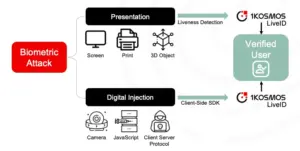Defeating AI-Generated Deepfake Biometric Attacks
In our digital era, presentation, and injection biometric attacks pose an unprecedented threat to the sanctity of identity verification. As we navigate a landscape increasingly dependent on digital transactions, the looming menace of AI-generated deepfakes demands innovative strategies to combat identity fraud. Gartner Analysts Akif Khan and Swati Rakeja affirm this urgency, stating, “Identity verification leaders must understand this emerging threat and take a proactive approach to secure their solutions*.”
*Emerging Tech: The Impact of AI and Deepfakes on Identity Verification – Akif Khan and Swati Rakeja
Presentation attacks, also known as spoofing or imitation attacks, involve attempts to deceive biometric authentication systems using fake biometric samples, such as photos, videos, or other replicas of the genuine user. With the advent of deepfakes, the methods used to detect presentation attacks have become outdated as many deepfake videos are very well created to be presented as a live video, with great rendering of an attacker superimposing their image on a live video.
One way to identify genuine users and prevent presentation attacks, like deepfakes, is through “liveness detection.” Liveness detection helps distinguish between genuine, live individuals and manipulated synthetic representations. Here’s how liveness detection helps identify users:
- Dynamic Movement Recognition: Liveness detection systems analyze the dynamic aspects of facial expressions, eye movements, and other micro-expressions that occur naturally in live subjects.
- Response to Stimuli: Liveness detection may involve prompting the user to perform specific actions or respond to stimuli during verification.
- 3D Depth Analysis: Liveness detection often utilizes advanced techniques like 3D depth analysis. By assessing the three-dimensional aspects of facial features, the system can verify the spatial relationships between different facial elements, making it harder for static images or videos to pass as authentic.
- Texture and Reflection Analysis: Liveness detection examines surface characteristics such as texture and reflections on the face. Natural skin has unique textures and reflects light in specific ways that may be hard to emulate.
All these technology components have been embedded across various liveness detection engines and have effectively prevented a “Presentation Attack” often used to game the system. Most deepfake attacks happen when an attacker injects a fraudulent video to game the liveness detection engine. There are usually three types of injection attacks that occur:
- Virtual H/W Camera Injections: Utilizing a virtual camera instead of a real camera to submit a photo or video. Software like Manycams is used to do this.
- JavaScript Injections: Utilizing browser console to inject spoofing JavaScript code to be run instead of existing one on the webpage
- Client Server Protocol Injections: A fraudster breaks the data channel between the browser and server or Classic IT infrastructure “Man in the Middle” type of attack.
Defeating Presentation Attacks with 1Kosmos
1Kosmos responds to this challenge with LiveID and LiveID+. LiveID leverages the front-facing camera on the mobile device (selfie camera) and records a video of the user. Once LiveID has determined the user is genuine, through a liveness check, LiveID will capture a “selfie” of the user and use it as a biometric reference for authentication. LiveID+ is an advanced SDK client-side solution. By actively identifying and thwarting injection attacks in real time, LiveID+ sets a new standard for security, offering robust protection against the deceptive tactics of deepfakes.
Adding additional capabilities to LiveID with LiveID+ allows organizations to prevent this growing attack vector. The new client-side SDK will catch injection attacks and not permit any identity proofing or authentication attempt if an injection attack is detected.

The advent of deepfake technology poses a formidable challenge to identity verification processes. As our digital transactions surge and passwordless biometrics become mainstream, the threat from AI-generated deepfakes will become more pronounced. Liveness detection is a good way of combating presentation attacks. However, the evolution of more sophisticated injection attacks, especially those utilizing injection techniques, necessitates innovative security measures like LiveID and LiveID+.
